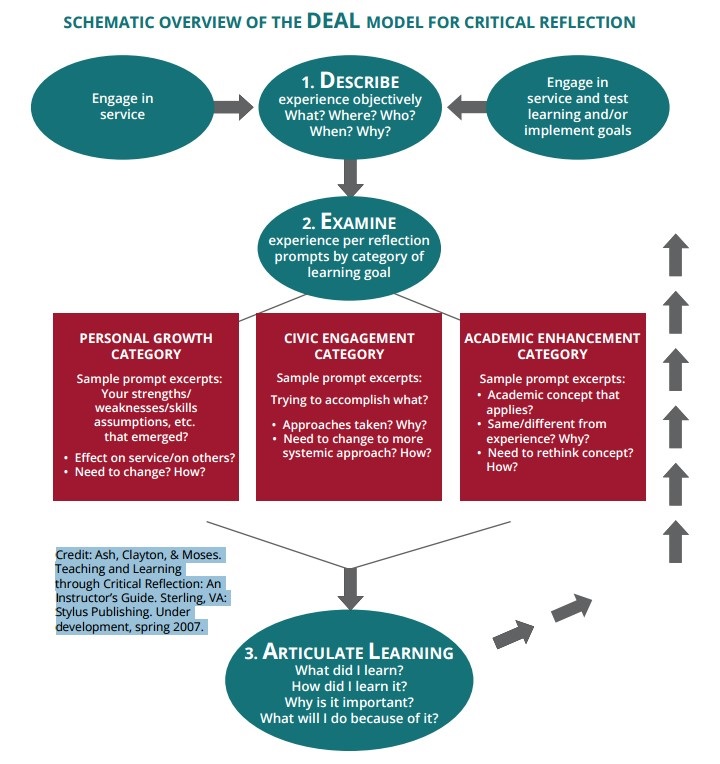Ash & Clayton (2009) define Critical Reflection as “evidence based examination of the sources of and gaps in knowledge and practice with the intent to improve on both (p. 28).” With this goal in mind, they develop a structure of “best practices” for creating critical reflection assignments and the associated assessments. Facilitators of experiential learning should follow 3 steps for optimal results.
1. Determine the desired learning goals and associated learning objectives, moving from description and explanation to evaluation and critique.
2. Create reflection assignments which relate directly to these learning objectives and require higher-order critical thinking skills.
3. Integrate summative and formative assessments into the reflection assignments.
The authors represent their approach in the DEAL model: Describe, Examine, and Articulate Learning. (Diagram 2 below) Using this approach, students take responsibility for their own learning. The first step, Describe, can happen before, during, and after the EL activity. To avoid shallow lists or mundane diary entries, the reflection prompts must encourage mindful and attentive descriptions of the activity. The Examine stage of critical reflection builds upon this foundation. Reflection questions which ask the student to examine their experience allows them to make meaning out of their EL activity by identifying the links between the learning objectives and their personal experience. The final step, Articulate Learning, enables students to capture their learning so that they can act on it. This can only happen if students can clearly articulate their learning process. Answering questions such as: What did I learn?, How did I learn it? Why does it matter? and What will I do now? will transform the student’s experience into substantive, applicable learning.
For Ash & Clayton, assessment must be developed in tandem with critical reflection activities. Assessment, like the reflection questions themselves, must link explicitly with the learning goals as objectives of the EL activity. As such, assessment needs to incorporate both the Describe and the Examine aspects of the Deal model. Summative assessments would evaluate the student’s accomplishment of the learning objectives while formative assessments would provide the feedback necessary for students to act on their learning. The authors describe the creation of critical reflection and assessment as modeling the EL learning process, with the opportunity for teachers to continuously learn from their students’ responses to improve the experience, the efficacy of the reflection assignments, and student learning.
Diagram 2(from Kleinhesselink, K, et.al.)
References
Ash, S. L., & Clayton, P. H. (2009). Generating, deepening, and documenting learning: The power of critical reflection for applied learning. Journal of Applied Learning in Higher Education, 1(1), 25-48.
Kleinhesselink K, Schooley S, Cashman S, Richmond A, Ikeda E, McGinley P, Eds. (2015). Engaged faculty institute curriculum. Seattle, WA: Community-Campus Partnerships for Health.
